Extended Side Angle Pose - Utthita Parsvakonasana

Contents
Extended Side Angle Pose — Utthita Parsvakonasana (oo-TEE-tah PARZH-vuh-ko-NAHS-uh-nuh) — is a standing yoga pose that utilizes all of the muscles in the body. Its name comes from four Sanskrit words: “Utthita” — meaning “extended”, “Parsva” — meaning “side” or “flank”, “Kona” — meaning “angle”, and “Asana” — meaning “pose”.
The steep angles of Extended Side Angle Pose help to stretch muscles in the outer edge of your feet. It also helps to distribute weight along your feet, allowing you to massage your feet through the use of pressure and weight. The goal is to use your arms to counterbalance your lower body so that you can stretch diagonally across the body. This counter-balancing applies unique types of pressure to your lower legs.
Pose Detail
- By Type: Balancing Yoga Poses, Chest Opening Yoga Poses, Strengthening Yoga Poses
- Difficulty: Beginners
Step-by-Step Instructions
Benefits and Contraindications
Opens the chest and shoulders
Improves stamina
Massages the abdominal organs
Stretches the inner thighs, groins, and side body
Strengthens the quadriceps and hamstrings, as well as the hips, knees, and ankles
Irregular blood pressure (high or low)
Headache
Insomnia
Neck injury (avoid gazing upward)
Shoulder injury
Photo poses in different angles



Modifications and Props for Beginners
- Using the wall for back support and extended arm support, with few rounds of practice, will help in gaining confidence and also getting the alignment right. This eventually will improve and later can be done without wall support.
- Using of blocks, by placing them close to the foot which bends at the knee, helps to place the palm on the block while still stretching the chest and the shoulders. And slowly with practice the flexibility of the legs improve and one can perform this pose without the support of the blocks.
- If the knee feels tight, one could place a strong stool or chair in front of the bend knee for extra support. But make sure the stool does not move while in the pose. One could also place the foot close to the wall while facing the knee towards the wall for support.
Useful Tips
To gain the benefits of Parsvakonasana, it’s important to practice it with correct alignment. Keep the following information in mind when practicing this pose:
- Work on getting the foot and leg placement first. Build the pose from the ground up.
- Do not allow your torso to drop forward in the pose. This often happens if you’re straining too hard to reach your front fingertips to the floor. Instead of trying to touch the floor, work to keep your hips, chest, shoulders, legs, and head along the same line. Imagine that you’re practicing the pose between two waterfalls. If you drop your torso forward or lean too far back, you will get wet. Work to keep your body “dry.”
- Keep the outer edge of your back foot pressing firmly into the mat. Try to ensure your back baby toe is on the mat.
- Keep your front knee aligned with your front heel. Do not allow the knee to drift inward — this can strain the knee joint. Instead, imagine it slightly moving out toward the baby toe.
Extended Side Angle Pose anatomy
Utthita Parsvakonasana targets the legs, hips, and core while also stretching the chest and shoulders.
- Legs: Extended Side Angle Pose primarily strengthens and stretches the muscles of the legs, including the quadriceps, hamstrings, and adductors (inner thigh muscles). As the front knee bends and the back leg extends, these muscles are activated and engaged to support the posture.
- Hips: The hip joint is also actively engaged in Extended Side Angle Pose, as the front hip is flexed and the back hip is extended. This helps to stretch the hip flexors and quadriceps of the back leg, while also strengthening the glutes and outer hip muscles of the front leg.
- Core: The core muscles, including the rectus abdominis, obliques, and transverse abdominis, are also engaged in Extended Side Angle Pose to support the stability and balance of the posture. This helps to strengthen and tone the muscles of the core, while also improving overall body awareness and control.
- Chest and Shoulders: As the front arm extends towards the ceiling, the chest and shoulder muscles are stretched and opened. This includes the pectoralis major and minor, as well as the anterior deltoid and serratus anterior muscles.
- Spine: Finally, Extended Side Angle Pose also helps to stretch and strengthen the muscles of the spine, including the erector spinae and multifidus muscles. This can help to improve spinal mobility and posture, while also reducing tension and stiffness in the back.
Frequently Asked Questions
Variations
- Extended Side Angle Pose With A Block
- Extended Side Angle Pose In A Chair
- Bound Extended Side Angle